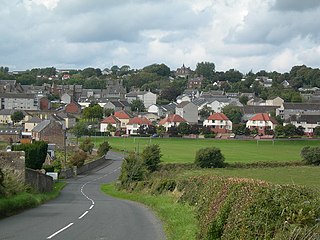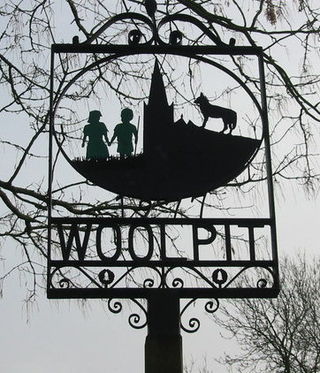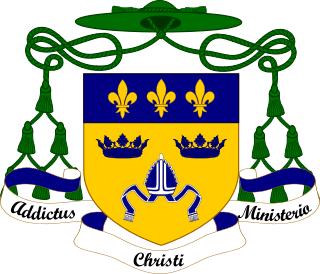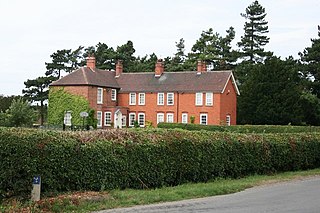
Lancing is a large coastal village and civil parish in the Adur district of West Sussex, England, on the western edge of the Adur Valley. It occupies part of the narrow central section of the Sussex coastal plain between smaller Sompting to the west, larger Shoreham-by-Sea to the east, and the parish of Coombes to the north. Excluding definitive suburbs it may have the largest undivided village cluster in Britain. However, its economy is commonly analysed as integral to the Brighton/Worthing/Littlehampton conurbation. Its settled area beneath the South Downs National Park covers 3.65 square miles, the majority of its land.

Lewisham is an area of southeast London, England, six miles south of Charing Cross. It is the principal area of the London Borough of Lewisham, and was within the historic county of Kent until 1889. It is identified in the London Plan as one of 35 major centres in Greater London, with a large shopping centre and street market. Lewisham had a population of 60,573 in 2011.

Motherwell is a town and former burgh in North Lanarkshire, Scotland, United Kingdom, south east of Glasgow. It has a population of around 32,120. Historically in the parish of Dalziel and part of Lanarkshire, Motherwell is the headquarters for North Lanarkshire Council. Geographically the River Clyde separates Motherwell from Hamilton to the west whereas the South Calder Water separates Motherwell from Carfin to the north-east and New Stevenston and Bellshill towards the north.

"O Holy Night" is a sacred song for Christmas performance. Originally based on a French-language poem by poet Placide Cappeau, written in 1843, with the first line "Minuit, Chrétien, c'est l'heure solennelle" that composer Adolphe Adam set to music in 1847. The English version is by John Sullivan Dwight. The carol reflects on the birth of Jesus as humanity's redemption.

Maybole is a town and former burgh of barony and police burgh in South Ayrshire, Scotland. It had an estimated population of 4,580 in 2020. It is situated 9 miles (14 km) south of Ayr and 50 miles (80 km) southwest of Glasgow by the Glasgow and South Western Railway. The town is bypassed by the A77.

Our Lady of Mount Carmel, or Virgin of Carmel, is the title given to the Blessed Virgin Mary in her role as patroness of the Carmelite Order, particularly within the Catholic Church. The first Carmelites were Christian hermits living on Mount Carmel in the Holy Land during the late 12th and early to mid-13th century. They built in the midst of their hermitages a chapel which they dedicated to the Blessed Virgin, whom they conceived of in chivalric terms as the "Lady of the place." Our Lady of Mount Carmel was adopted in the 19th century as the patron saint of Chile.

Lewisham parks and open spaces are part of the "green lung" of London and include a diverse range of sites, from small urban parks and gardens to one of the most historic natural landscapes in Greater London at Blackheath. While overall control rests with London Borough of Lewisham, management of borough-owned parks and their facilities is contracted out to Glendale Grounds Management.

Ladywell is a locale in Lewisham in South East London, England, and a ward in the London Borough of Lewisham between Brockley, Crofton Park and Lewisham proper. It has ample green space including Ladywell Fields and Hilly Fields which borders Brockley. Ladywell Village, the main shopping area along Ladywell Road, was given a facelift in 2013 with £800,000 of Transport for London funding. The pavements were widened, short stay bays created to help local businesses and shoppers, and trees were added. Ladywell Village has a range of retail outlets including a number of cafes, a patisserie and a delicatessen.
Lad or lads may refer to:

The legend of the green children of Woolpit concerns two children of unusual skin colour who reportedly appeared in the village of Woolpit in Suffolk, England, sometime in the 12th century, perhaps during the reign of King Stephen. The children, found to be brother and sister, were of generally normal appearance except for the green colour of their skin. They spoke in an unknown language and would eat only raw broad beans. Eventually, they learned to eat other food and lost their green colour, but the boy was sickly and died soon after his sister was baptized. The girl adjusted to her new life, but she was considered to be "very wanton and impudent". After she learned to speak English, the girl explained that she and her brother had come from a land where the sun never shone, and the light was like twilight. According to one version of the story, she said that everything there was green; according to another, she said it was called Saint Martin's Land.

Alexander's School, at 94 Duke Street, Glasgow, was designed by John Burnet and built in 1858 at a cost of £6000 for James Alexander, the proprietor of the cotton mill next door - itself an innovative 1849 fire-proof construction - to educate local children. It was known as "Alexander's Endowed School".

The Lady Well is a holy well in Glasgow in Scotland.

The Roman Catholic Diocese of East Anglia is a diocese of the Latin Church of the Roman Catholic Church covering the counties of Cambridgeshire, Norfolk, Suffolk, and Peterborough in eastern England. The diocese makes up part of the Catholic Association Pilgrimage.

Woolpit is a village in the English county of Suffolk, midway between the towns of Bury St. Edmunds and Stowmarket. In 2011 Woolpit parish had a population of 1,995. It is notable for the 12th-century legend of the green children of Woolpit and for its parish church, which has especially fine medieval woodwork. Administratively Woolpit is a civil parish, part of the district of Mid Suffolk.

Ladywell is an area, primarily residential in Livingston, West Lothian, Scotland. It is bordered to the north by Knightsridge, to the south by Howden, to the west by Eliburn and to the east by the A899 road.

Brockley and Ladywell Cemeteries were opened within one month of each other in 1858 and are sited on adjacent plots of previously open land. The two component parts are characteristic examples of the first wave of Victorian public cemeteries and are now part of the Brockley Conservation Area.

Ladywell Fields, originally Ladywell Recreation Ground is a public park in the London Borough of Lewisham created from three historic fields. It is located near Ladywell railway station at the northern end of the park, and Catford Bridge at the southern end.

Headon cum Upton is a civil parish in the Bassetlaw district, in the county of Nottinghamshire, England. The parish includes the villages of Headon, Upton and the hamlet of Nether Headon. The parish is adjacent to Askham, Gamston, East Drayton, Eaton, Grove, Rampton and Woodbeck, Stokeham and Treswell. In 2011 the parish, together with Stokeham had a population of 253. The area is 3.5 miles south east of the nearest market town Retford, 26 miles north east of the county town Nottingham and 125 miles north of London. Headon cum Upton shares a parish council with Grove and Stokeham. There are 6 listed buildings in Headon cum Upton.

Nether Headon is a hamlet in Headon cum Upton civil parish, within the Bassetlaw district, of the county of Nottinghamshire, England. It is 3.5 miles south east of the nearest market town Retford, 26 miles north east of the county town Nottingham and 125 miles north of London. The hamlet is adjacent to the villages of Upton, Headon, East Drayton, Eaton, Grove, Woodbeck and Stokeham. In 2011 the parish, together with Stokeham had a population of 253.

Saint Mary's Church is the parish church of Woolpit, Suffolk, England. Much of the church was built in the fifteenth century. but its most salient feature, the spire was added in 1870, thanks to the architect Richard Phipson.

















